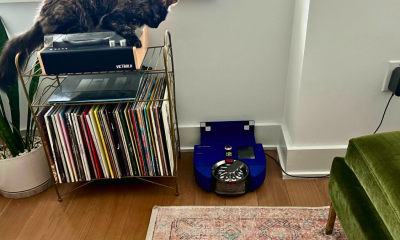Entertainment
Behind the high-tech scenes of ‘Alita: Battle Angel’

More than two years ago, 20th Century Fox invited the press to the set of Alita: Battle Angel, which had just started production. It was all very hush-hush, and we agreed not to report on what we’d seen, heard, and done on the backlot until the film’s launch in February 2019.
In November 2016, I awoke early in Austin, Texas, and was driven to a site that was previously the city’s main airport. It’s now home to Troublemaker Studios, founded in 1999 by the film’s director, Robert Rodriguez, and producer Elizabeth Avellán.
Carved out of two massive airplane hangars, Stage 1 (9,460 square feet) and Stage 2 (14,000 square feet) loomed large over background artists dressed in futuristic dystopian garb, who milled around grabbing breakfast from craft services. We were whisked through office hallways, the art department, wardrobe, and the Mill Space (fiberglassing, blow torches, vast sets, and lots of shouted commands to “Mind that cable!”) before arriving in a dark screening room.
Producer Jon Landau (Titanic, Avatar) was waiting for us. He told the technicians in the control box to “run picture,” and we got a whiz-bang “just the good bits” of what Rodriguez had in the can thus far.
The movie follows Alita (Rosa Salazar), an Android who wakes up in an unfamiliar future. She learns to navigate the streets of Iron City with the help of Ido (Christoph Waltz) and Hugo (Keean Johnson), but Alita has unique fighting abilities that the corrupt forces who run the city would like to control.
As the lights went up in the screening room, Landau introduced Salazar, who provided a spoiler-free explanation of Alita’s narrative arc from abandoned cyborg shell to battle-scarred warrior. She was already in “costume”—with dots on her face and markers covering her torso and limbs, she was ready for some performance-capture magic courtesy of James Cameron’s Lightstorm Entertainment.
It was time, then, to see it for ourselves. Escorted onto the back lot of Iron City, we watched, from a safe distance, as Jennifer Connelly patiently went through take after take, while Rodriguez tried out new ideas. We saw the scene unfold from Salazar’s point of view on nearby monitors.
When Rodriguez wrapped for the day, we joined him and Landau in the film’s “Kansas Bar” set for rolling interviews. Here are edited and condensed excerpts from our conversations.
Robert Rodriguez, let’s go straight for geek detail.
[RR] [Laughs] Sure.
Is it true, in the early 2000s that George Lucas asked you to attend a digital gathering?
[RR] Wow, that was the early days. I just shot two digital films at that time and George Lucas called me. He’d done the second Star Wars. Francis [Ford] Coppola [also] had shots and tests and [they] wanted to have a visual gathering and show directors in Hollywood what digital could do, because some hadn’t really heard about it, or seen it in action.
That must have been an amazing group of people at Lucas’ pad.
[RR] It was a hoot. Steven Spielberg was there, [and] Michael Bay. It felt like the sky was the limit back then.
This was before you’d shot the movie you’re most known for, Sin City?
[RR] Yeah. It was before I’d done Sin City, so to be introducing Hollywood to something very new… It seems like everything leapfrogged from then to where we are now.
Jon, can you give us some background on the technology in Alita: Battle Angel?
[JL] This is the tech we’ve been developing, going back before we even started Avatar. In an earlier test shoot, for [a movie that never got made, based on the novel] Brother Termite, when aliens were arriving, we had an actor perform with an umbrella rig around his head—12 cameras—everywhere. We saw a future where we would use that facial performance capture to drive performance rather than animating it.

Rosa Salazar stars as Alita in ‘Alita: Battle Angel.’
Image: Twentieth Century Fox
And that was what originally inspired James Cameron?
[JL] When Jim Cameron saw the test he was so convinced by the nuances that we had captured—with ILM [Industrial Light & Magic] and [VFX lead] Dennis Muren.
[RR] James Cameron was always good about that. He always wanted to start telling stories before the technology was invented. He never held back. He knew that by the time he got to post production, it would be there. We take it for granted but there have been so many innovations in the past 15-plus years.
Jon, over the years you’ve refined the system massively.
[JL] The giant system [we have today], when it loses a data point it’s still able to solve for the skeleton and what the muscles do. We now own that system. [In our partnership with] Weta Digital … we’re now [able] to create Rosa Salazar’s performance from the inside, driving the performance from a muscle base—not putting a mask on the actor through animation—to make sure we are living up to the performance that Rosa is giving us.
[RR] Just being able to point to a camera, [and being] able to see what’s there [is great]. Back in the day I called it “guess cam” but now I can see. You can frame it as if it’s live action; that’s a great innovation.
It must be important for the actors to see what their performance will be like, rather than waiting for post-production, a year hence.
[RR] The performance capture that we have today, where we can be in any location, and have a character really emerging on set, at the pace we go—because I shoot very fast—[is amazing]. Not having any of that technology slow you down.
Plus it’s a faithful performance, to the one the actor gives. Not an animated overlay.
[JL] Film is a collaborative art. When we talked to our cast on Avatar, we made the same commitment we made to Rosa [on Alita: Battle Angel]. It will be theirperformance on screen.
The level of VFX on Alita: Battle Angel looks extraordinary, with a rumored budget of $200 million. It must be great for geeks on set.
[RR] At WETA Digital, they’ve got everything working so perfectly with our performance capture it can blend very seamlessly together. I’ve never had that high caliber a visual effects company work with me. I’m pretty technically proficient and I usually do my own visual effects supervisor role, but now I get to geek out with [Weta Digital]. We can take it to another level having them and their knowledge.
Alita: Battle Angel hits theaters on Feb. 14.
This article originally published at PCMag
here
-

 Business4 days ago
Business4 days agoAPI startup Noname Security nears $500M deal to sell itself to Akamai
-

 Business6 days ago
Business6 days agoYoshi Mobility has come a long way since gassing up cars on the side of the road
-

 Entertainment4 days ago
Entertainment4 days agoHow to watch ‘Argylle’: When and where is it streaming?
-

 Entertainment4 days ago
Entertainment4 days agoNASA discovered bacteria that wouldn’t die. Now it’s boosting sunscreen.
-

 Business4 days ago
Business4 days agoUS think tank Heritage Foundation hit by cyberattack
-

 Entertainment4 days ago
Entertainment4 days agoDyson 360 Vis Nav robot vacuum review: Dyson should just stick to upright vacuums
-

 Business3 days ago
Business3 days agoTesla drops prices, Meta confirms Llama 3 release, and Apple allows emulators in the App Store
-

 Entertainment4 days ago
Entertainment4 days agoCrypto and taxes: Which forms you need to file



















